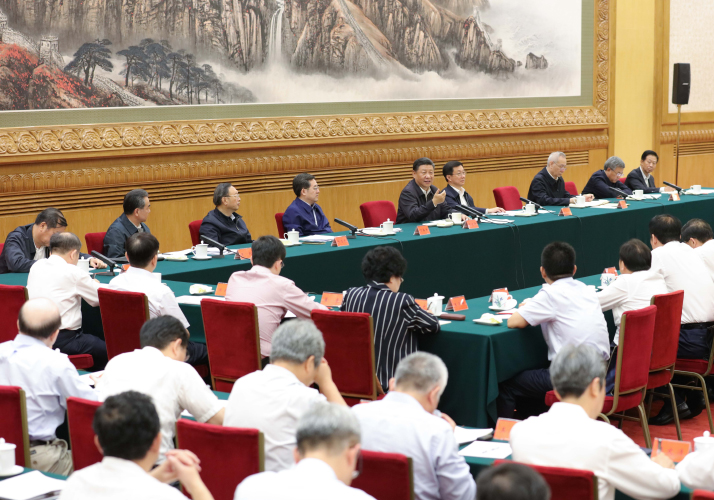| World |
| Belt and Road Turns Five | |
| Cooperation and growth characterize the first five years of the initiative | |
|
|
 President Xi Jinping addresses a symposium marking the fifth anniversary of the Belt and Road Initiative in Beijing on August 27 (XINHUA)
Five years ago, in the autumn of 2013, Chinese President Xi Jinping proposed the building of the Silk Road Economic Belt during a visit to Kazakhstan and the 21st-Century Maritime Silk Road while in Indonesia, which have collectively become known as the Belt and Road Initiative. The initiative serves as a solution for China to participate in global opening up and cooperation, improve global economic governance, promote common development and prosperity, and build a community with a shared future for mankind, Xi said at a symposium marking the fifth anniversary of the Belt and Road Initiative in Beijing on August 27. He called for efforts to uphold dialogue and consultation, joint contribution, shared benefits, win-win cooperation, exchange and mutual learning and to promote mutual political trust, economic integration, and people-to-people exchanges with Belt and Road countries in order to advance the initiative step by step to produce results. As of July, more than 100 countries and international organizations had signed Belt and Road cooperation documents with China, extending the initiative's scope from the Eurasian continent to Africa, Latin America and the Caribbean, and the South Pacific. China's total trade with countries along the Belt and Road in the past five years exceeded $5 trillion, with annual average growth of 1.1 percent, according to Qian Keming, Vice Minister of Commerce. "China has become the largest trading partner of 25 of these countries," Qian said at a press conference held by the State Council Information Office in Beijing on August 27. High-quality development The next priority for jointly advancing the Belt and Road Initiative is to realize its high-quality development, Xi said at the symposium. He urged efforts to push for progress in Belt and Road projects, especially those delivering real benefits to local people, and to keep expanding the market while maintaining a trade balance. Also in the past five years, 82 overseas economic and trade cooperation zones have been established in countries along the Belt and Road, with accumulated investment of $28.9 billion. The zones have attracted nearly 4,000 enterprises, creating $2 billion worth of tax revenue for these countries and providing 244,000 local jobs, Ministry of Commerce's data showed. Xi advocated a policy system of financial support for the initiative and encouraged private funding sources to invest in infrastructure and resource development projects in Belt and Road countries. The construction projects have gone through sound feasibility studies and strict loan reviews, with binding requirements on the proportion of property investment to total investment, asset-liability ratio and capital return, said Ning Jizhe, chief of the National Bureau of Statistics and Vice Minister of the National Development and Reform Commission, during the press conference. In 2014, China announced that it would contribute $40 billion toward a Silk Road Fund to support Belt and Road projects. A year later, the Asian Infrastructure Investment Bank, a China-initiated multilateral financial institution, was established. Xi stressed that investment activities should be regulated and businesses should operate in accordance with laws and regulations, pay attention to environmental protection and fulfill their social responsibilities. When making investments or financing Belt and Road projects, China always sticks to an economic benefit-oriented approach, extending loans based on the real conditions in the relevant countries, supporting project construction and avoiding the creation of more debt risks or an increase in the fiscal burdens of host countries, said Ning. In the first seven months of 2018, Chinese companies raised investment in 54 countries along the Belt and Road. This $8.55-billion investment represented an 11.8-percent increase year on year. Before financing a project, Chinese banks always scrutinize the liabilities and repayment abilities of borrowers. After extending loans, they continue to monitor country and sovereign risks, Ning added. Common development On August 26, freight train X8044 arrived in Wuhan in central China's Hubei Province from Hamburg, Germany, marking the completion of the 10,000th trip since the China-Europe freight rail service was launched in 2011. The expanding rail network has become an important part of the Belt and Road Initiative. It transports garments, auto parts, chemicals and other Chinese goods to Europe, while bringing European food, machinery, equipment and timber products to China. Xi pointed out that jointly pursuing the Belt and Road Initiative is not only aimed at economic cooperation but is also an important pathway to improving global development patterns and global governance and promoting the healthy development of economic globalization. In May 2017, Beijing hosted the first Belt and Road Forum for International Cooperation attended by state and government leaders from 29 countries. The more than 1,600 participants came from over 140 countries and 80 international organizations. Overall, the forum produced 279 agreements, among which 265 have been settled and another 14 are being negotiated. "The broad support for the Belt and Road Initiative shows the aspirations of countries involved—developing countries in particular—for peace and development," Xi said, noting that the initiative is a project for economic cooperation and not a geopolitical alliance or military league; it is an open and inclusive process rather than an exclusive bloc or so-called "China club." Xi said work should be done to boost exchanges in education, science, technologies, culture, sports, tourism, health and archaeology. Under the initiative, China has set up 81 educational institutions and projects as well as 35 cultural centers in countries along the Belt and Road. "It does not differentiate countries by ideology, nor play a zero-sum game. As long as countries are willing to join, they are welcome," Xi said. Copyedited by Rebeca Toledo Comments to zanjifang@bjreview.com |
|
||||||||||||||||||||||||||||||
|